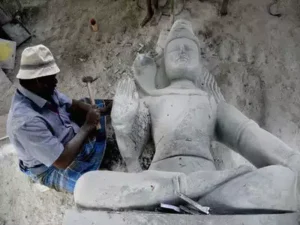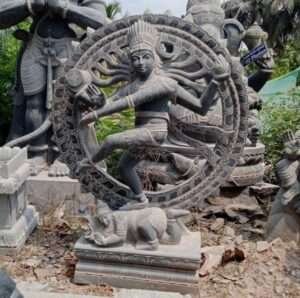Nestled on the shores of the Bay of Bengal, Mahabalipuram, an ancient coastal town in Tamil Nadu, India, beckons travelers and history enthusiasts to explore its awe-inspiring array of sculptural wonders. With a rich history dating back to the Pallava dynasty of the 7th and 8th centuries, Mahabalipuram is a UNESCO World Heritage Site, celebrated for its architectural prowess and artistic heritage.
Historical Odyssey
Mahabalipuram’s historical significance is deeply rooted in the Pallava dynasty, renowned for its patronage of art and culture. During this golden era, the Pallavas nurtured the development of art, leading to the creation of astounding architectural wonders that continue to captivate the world.
Crafting Marvels: The Art of Mahabalipuram Sculptures
Mahabalipuram sculptures were crafted in the 7th century CE using a technique called ‘rock-cut.’ Skilled artisans carved intricate designs directly into granite rock, chiseling and sculpting these magnificent creations with hand tools and hammers. The process involved careful planning, precise detailing, and immense craftsmanship.
Delving into Architectural Splendors
1. Arjuna’s Penance (Descent of the Ganges)
Arjuna’s Penance, a colossal open-air bas-relief, etches tales from Hindu mythology on two immense rocks. The intricacies and grandeur of this sculpture are a testament to the artisans’ skill and dedication, portraying a divine narrative with exquisite precision.
2. Shore Temple
The Shore Temple, overlooking the vast expanse of the Bay of Bengal, is a structural masterpiece adorned with intricate carvings. The fusion of Dravidian and Pallava architectural styles showcases the Pallavas’ architectural finesse and devotion to Lord Shiva.
3. Pancha Rathas (Five Chariots)
The Pancha Rathas, a group of five monolithic temples, astound with their intricate carvings and distinctive designs. Named after the Pandavas and Draupadi from the epic Mahabharata, each “ratha” or chariot represents a unique style, embodying ancient artistry.

4. Varaha Cave Temple
Dedicated to Lord Vishnu, the Varaha Cave Temple is a marvel of rock-cut architecture. The temple’s interior is adorned with detailed carvings depicting Lord Vishnu’s various avatars, a testament to the Pallava dynasty’s artistic brilliance.

Safeguarding the Legacy
Preserving Mahabalipuram’s ancient sculptures is a priority, with ongoing efforts to protect them from natural elements and human impact. Conservationists employ advanced scientific techniques and meticulous care to ensure the longevity of these historical treasures, allowing future generations to appreciate the beauty and cultural significance they embody.

In Conclusion
Mahabalipuram’s sculptural wonders serve as a time portal, offering a glimpse into an ancient era of architectural genius and artistic dedication. Each intricately carved piece narrates a story of devotion, culture, and craftsmanship, inviting travelers to walk through history and revel in the marvels of Mahabalipuram’s artistic heritage.


